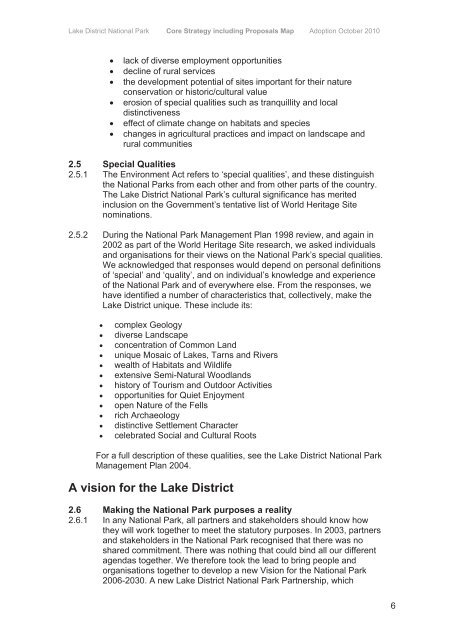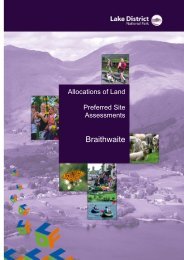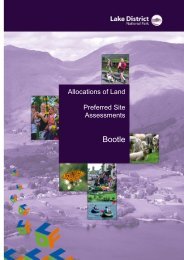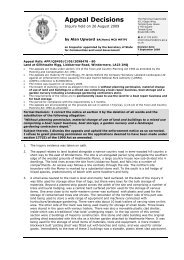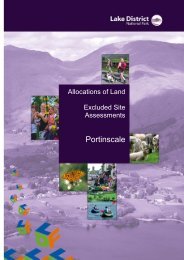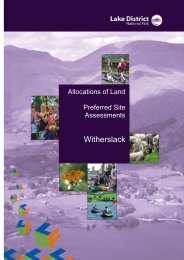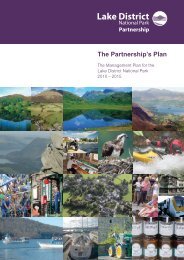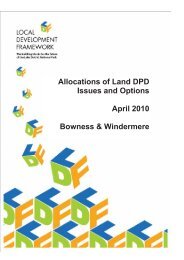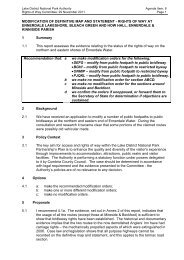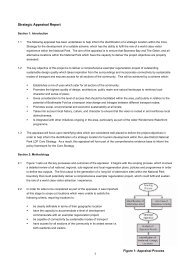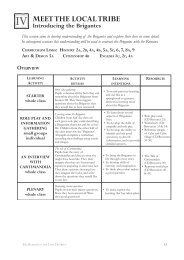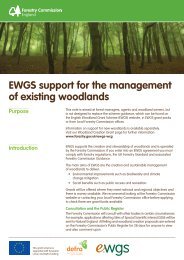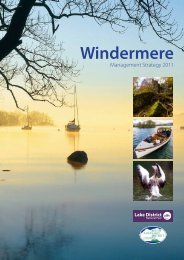Core Strategy (PDF) - Lake District National Park
Core Strategy (PDF) - Lake District National Park
Core Strategy (PDF) - Lake District National Park
You also want an ePaper? Increase the reach of your titles
YUMPU automatically turns print PDFs into web optimized ePapers that Google loves.
<strong>Lake</strong> <strong>District</strong> <strong>National</strong> <strong>Park</strong> <strong>Core</strong> <strong>Strategy</strong> including Proposals Map Adoption October 2010<br />
<br />
<br />
<br />
<br />
<br />
<br />
lack of diverse employment opportunities<br />
decline of rural services<br />
the development potential of sites important for their nature<br />
conservation or historic/cultural value<br />
erosion of special qualities such as tranquillity and local<br />
distinctiveness<br />
effect of climate change on habitats and species<br />
changes in agricultural practices and impact on landscape and<br />
rural communities<br />
2.5 Special Qualities<br />
2.5.1 The Environment Act refers to ‘special qualities’, and these distinguish<br />
the <strong>National</strong> <strong>Park</strong>s from each other and from other parts of the country.<br />
The <strong>Lake</strong> <strong>District</strong> <strong>National</strong> <strong>Park</strong>’s cultural significance has merited<br />
inclusion on the Government’s tentative list of World Heritage Site<br />
nominations.<br />
2.5.2 During the <strong>National</strong> <strong>Park</strong> Management Plan 1998 review, and again in<br />
2002 as part of the World Heritage Site research, we asked individuals<br />
and organisations for their views on the <strong>National</strong> <strong>Park</strong>’s special qualities.<br />
We acknowledged that responses would depend on personal definitions<br />
of ‘special’ and ‘quality’, and on individual’s knowledge and experience<br />
of the <strong>National</strong> <strong>Park</strong> and of everywhere else. From the responses, we<br />
have identified a number of characteristics that, collectively, make the<br />
<strong>Lake</strong> <strong>District</strong> unique. These include its:<br />
<br />
<br />
<br />
<br />
<br />
<br />
<br />
<br />
<br />
<br />
<br />
<br />
complex Geology<br />
diverse Landscape<br />
concentration of Common Land<br />
unique Mosaic of <strong>Lake</strong>s, Tarns and Rivers<br />
wealth of Habitats and Wildlife<br />
extensive Semi-Natural Woodlands<br />
history of Tourism and Outdoor Activities<br />
opportunities for Quiet Enjoyment<br />
open Nature of the Fells<br />
rich Archaeology<br />
distinctive Settlement Character<br />
celebrated Social and Cultural Roots<br />
For a full description of these qualities, see the <strong>Lake</strong> <strong>District</strong> <strong>National</strong> <strong>Park</strong><br />
Management Plan 2004.<br />
A vision for the <strong>Lake</strong> <strong>District</strong><br />
2.6 Making the <strong>National</strong> <strong>Park</strong> purposes a reality<br />
2.6.1 In any <strong>National</strong> <strong>Park</strong>, all partners and stakeholders should know how<br />
they will work together to meet the statutory purposes. In 2003, partners<br />
and stakeholders in the <strong>National</strong> <strong>Park</strong> recognised that there was no<br />
shared commitment. There was nothing that could bind all our different<br />
agendas together. We therefore took the lead to bring people and<br />
organisations together to develop a new Vision for the <strong>National</strong> <strong>Park</strong><br />
2006-2030. A new <strong>Lake</strong> <strong>District</strong> <strong>National</strong> <strong>Park</strong> Partnership, which<br />
6


